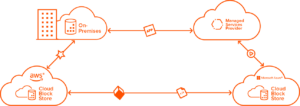Organizations want the same experience regardless of where their data lives—on-premises, cloud, hybrid cloud, multicloud—without sacrificing the enterprise on-prem features.
And yet, many face common drawbacks in multicloud adoption.
- Lack of interoperability
- Lack of cost efficiency
- Lack of enterprise-reliability features
We developed Pure Cloud Block Store™ to address pain points many organizations were facing and bridge the cloud divide.
Bridging the Gap Between On-premises and Cloud
On-premises and cloud platforms differ in resiliency, storage efficiency, and APIs. This creates a divide between on-premises and cloud capabilities:
- Resiliency and efficiency. On-premises, you have highly reliable arrays with lots of enterprise features. You also have thin provisioning, dedupe, and compression. In the cloud, everything is thick provisioned and you pay separately for capacity and performance.
- APIs. Many on-prem operational practices are manual, whereas in the cloud, everything is API-driven.
Pure Cloud Block Store bridges this divide in a few ways:
- It enhances the storage resiliency of the cloud. When you deploy mission-critical applications, you must ensure that your applications and data are resilient to single points of failure. Pure Cloud Block Store offers built-in data protection that leverages multiple high-availability zones (AZs), to reduce physical fault domain exposure. For the ultimate level of data protection and business continuity, you can replicate data between AZs and regions.
It uses the same APIs as Pure FlashArray™. Pure Cloud Block Store provides an abstraction layer that enables you to easily deploy in hybrid-cloud and multicloud environments. You get the same cost efficiency you experience with FlashArray from Pure’s industry-leading storage efficiencies of thin provisioning, deduplication, and compression.

Figure 1. Pure Cloud Block Store delivers seamless bi-directional data mobility and a consistent experience across all data domains with common APIs and a common data plane.
Pure Cloud Block Store vs. Cloud-native Storage
Why use Pure Cloud Block Store instead of cloud-native storage alone?
One thing that differentiates Pure Cloud Block Store is its abstraction layer, which enables you to easily move to a hybrid-cloud or multicloud environment. Leveraging underlying cloud components and applying Pure’s industry-leading data-reduction techniques creates a performant, cost-effective solution. The unique architecture enables us to upgrade any component in the stack without disruption.
How to Gain Portability and Visibility for Multicloud Success
Organizations are increasingly adopting a multicloud strategy—placing applications and data in two or more clouds in addition to an on-premises environment. Workload portability is fundamental to multicloud success, and software-defined storage (SDS) is key.
SDS simplifies data portability and delivers a consistent user experience regardless of the environment where the data lives. This gives you the flexibility to easily move data from on-premises to any cloud you choose.
Abstracting applications and data from their underlying hardware also allows you to consolidate silos. Data silos cause fragmentation that limits your visibility and collaboration. They can’t communicate, creating a management nightmare and added complexity.
Tap Into The Benefits of Multicloud with Microsoft and Pure
The fact that Pure Cloud Block Store runs seamlessly on both AWS and Azure (beta) is significant to many organizations that have a comprehensive data strategy. Organizations are using Pure Cloud Block Store for:
- Disaster recovery: Cloud economics, automation, data replication, and recovery orchestration have made disaster recovery (DR) to the cloud ideal, especially if you’re operating from a single physical site. With Pure Cloud Block Store, you can replicate to the cloud cost efficiently. And its always-on encryption combined with cloud-native cybersecurity provide a compliant solution that safeguards data while preserving its integrity.
- DevTest: Instantly provision clones of production workloads in the cloud to accelerate development cycles and expand your testing capabilities. Pure Cloud Block Store lets you make snapshots and clones in the cloud, meaning you don’t have to purchase and deploy new on-premises hardware. These snapshots and clones consume no additional cloud storage, supporting better software time-to-market and TCO.
- Cloud migration: Refactoring and redesigning existing applications is the biggest pain point of cloud migration. To work around availability vulnerabilities arising from a single point of failure, you have to refactor or redesign your applications—which can be time-consuming and costly. Pure Cloud Block Store removes this limitation with an architecture that provides high availability.
- High availability: Pure Cloud Block Store supports continuous uptime, better agility, and decreasing costs. You get high-data availability and resiliency within an AZ or multi-regional AZs, and replicas stay synchronized with master data sets.

Figure 2. Replicate to multiple high-availability zones in the cloud bi-directionally while keeping replicas in sync with master data.
Microsoft and Pure Storage Synergies
Pure Storage has a close and long-running partnership with Microsoft on technologies like SQL Server. Pure Cloud Block Store also runs seamlessly with Azure Kubernetes Service, leveraging Pure Service Orchestrator™. Our teams worked closely with Microsoft to define Azure Shared Disks, the new Azure storage feature that allows you to attach a managed disk to multiple virtual machines (VMs) simultaneously.
By leveraging Azure Shared Disks, we can non-disruptively upgrade hardware and software, and you can upgrade your Azure services without effort. In Figure 3, controller 1 and controller 2 each have a connection to a shared pool of disk resources. Controller 1 is actively using those resources while controller 2 is in a standby configuration. You can update the software on controller 2, then failover so that it’s active. Then, you can update VM 1 with non-disruptive upgrades and within failover timeouts.

Figure 3: Azure Shared Disks provide shared access to Pure Cloud Block Store, which can be leveraged by multiple VMs.
Leveraging Azure Shared Disks for this important attribute enabled our teams to improve time to market for Pure Cloud Block Store on Azure. Kunal Kapoor from our team put it best in Microsoft’s Shared Disks blog post:
“With Azure Shared Disks, we can provide a comprehensive high-availability solution on Azure for our joint customers migrating their production applications and primary storage infrastructure to the cloud.”—Kunal Kapoor, Director Product Management, Pure Storage






